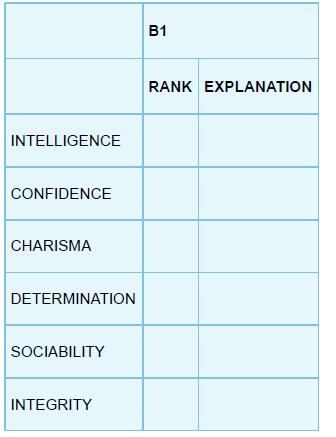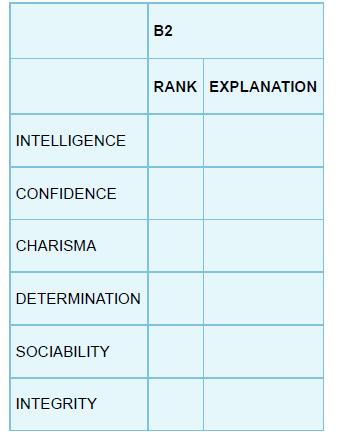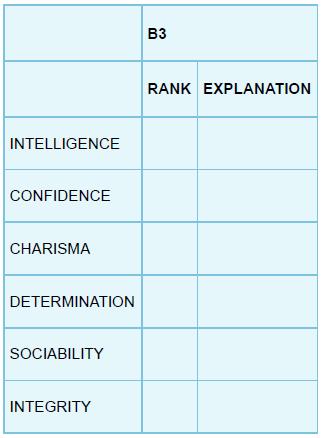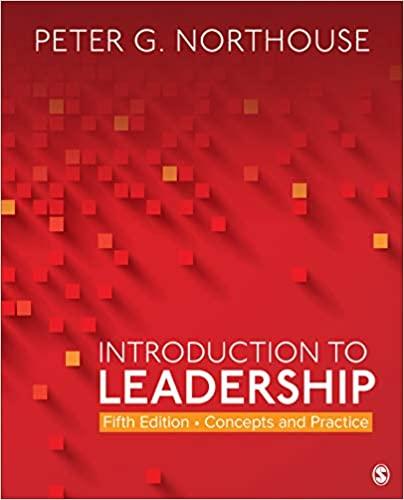The three Bs are three recent college graduates at the precipice of their careers. Having each completed
Question:
The three Bs are three recent college graduates at the precipice of their careers. Having each completed their education from prestigious American universities, all three are destined to become important and influential leaders. Following is a snapshot of the lives of each of these future leaders at the time of their college graduation. As you read through each person’s biography, pay particular attention to the traits and characteristics of these graduates, noticing which will serve them as they mature into the leaders they become.
B1 grew up in a rural, Southern state and, at a young age, knew his path lay in politics. Influenced by John F. Kennedy and Martin Luther King Jr., B1 would later admit, “Sometime in my sixteenth year, I decided I wanted to be in public life as an elected official. I loved music and thought I could be very good, but I knew I would never be John Coltrane or Stan Getz. I was interested in medicine and thought I could be a fine doctor, but I knew I would never be Michael DeBakey. But I knew I could be great in public service. I thought I could make it without family wealth, or connections, or establishment southern positions on race and other issues.”1 B1 was born to a widowed mother and never knew his father. His early years were influenced greatly by the two strong women in his life: his mother and his grandmother. His mother was fun loving and vivacious, leaving her young son in his grandparents’ care while she studied nursing in a neighboring state. His grandmother, by contrast, was a strong-willed disciplinarian, instilling in B1 a lifelong love of reading. When B1 was 4, his mother married the man who would become his stepfather, a local car dealer and an abusive alcoholic. B1 often intervened in the violent arguments that broke out in his home and protected the secrets of his home life as the children of alcoholics often do. He was 15 when his mother ended the marriage.
B1 attended Catholic schools and, later, a local public high school. The high school was segregated, a dogma B1 had difficulty accepting. Charming, handsome, and intelligent, he was an active student leader and musician, playing the saxophone and winning first chair in the state band. Highly interested in politics, he participated in both Boys State and Boys Nation, which provided him the opportunity to meet his idol, President Kennedy.
B1 was mentored by his high school principal, a woman known for her commitment to “produce leaders who thought of personal success in terms of public service”2 and who recognized B1 as a “young man of rare talent and ambition.”3 It was in the halls of his high school that B1 found his passion for law, informing his Latin teacher of his intent to study law after a mock trial exercise for her class.
Following high school, B1 attended Georgetown University, which he financed through scholarships and part-time jobs. He was a member of Phi Beta Kappa (the prestigious academic honor society), an honorary band fraternity, and a service fraternity. B1 was elected class president twice and interned and clerked for the senator from his home state.
Following his graduation with a degree in foreign service, B1 won a prestigious Rhodes Scholarship to University College, Oxford, England, but left Oxford after a year to study law at Yale University.
B2 was the eldest child of a prestigious and wealthy family. His father and grandfather were prominent U.S. political leaders, and his mother the daughter of a successful publisher. B2’s ancestry traced directly to the American colonists. The death of his 3-year-old sister when B2 was 7 devastated his family. Left an only child for a time, he brought consolation to his mother through his humor, playfulness, and good cheer, a role he often relied upon as he matured into adulthood...............
Questions
Before the identities of these future leaders are revealed, complete Question 1.
1. Rank the strength of each person (on a scale of 1 to 10, with 10 as high) for each leadership trait listed. Use the “explanation” column to support your ranking. B1, B2, and B3 all became influential world leaders, serving as consecutive U.S presidents. You may recognize them as President Bill Clinton (B1), President George W. Bush (B2), and President Barack Obama (B3).






2. The chapter strongly implies that leadership is about traits—people become leaders because of their traits. In light of what you know about these men and their presidencies, do you feel the traits approach adequately captures the essence of their leadership? Does nurturance play an equal or more important role? Why or why not?
3. Of all the traits exhibited by these three leaders, what one trait would you like to have for yourself? Explain why.
Step by Step Answer:

Introduction To Leadership Concepts And Practice
ISBN: 9781544351599
5th Edition
Authors: Peter G Northouse





